How Biochar Can Help the Environment and Climate Change:
Abstract
Biochar is a form of charcoal. It is believed by many to present vast chances in enhancing crop growth, remediating contaminated soil and preventing climate change causing carbon emissions. Biochar is also known as agrichar or the simple term, black carbon.

How is Biochar Made
Biochar production by using a process called pyrolysis. The porous charcoal like biochar was organic biomass. Pyrolysis involves placing the biomass into a special oven before heating in the presence of no oxygen. The result is a stable solid material rich in carbon content that can effectively capture carbon and lock the carbon into the soil. Temperatures needed by this process change and a different type of biochar are manufactured depending on the feed biomass used and the temperature reached in the pyrolysis process.

History of Biochar
The highly fertile dark soils of the Amazon River basin indicate that a form of biochar has been used in agriculture for many hundreds of years. These dark soils contain a fine-grained, carbon-rich material. This material comes from charred organic materials like manure, crop residue, and bones that were added to the soil. Without sophisticated kilns and ovens to produce modern biochar, this ancient material was likely made by setting alight a pile of organic material before covering it with dirt to remove oxygen but hold in the heat from the fire which, in turn, baked the organic matter.
Using Biochar to Batter Climate Change
Carbon-containing materials such as plants are made from carbon that is sourced from the air. While alive and whole that organic matter holds the carbon in place but when it burns or decomposes the carbon is released back into the atmosphere in gases like carbon dioxide. These gases then contribute to climate change and global warming. If the organic material undergoes pyrolysis, then the carbon largely remains locked as a solid in the biochar and can remain in this stable form for hundreds or thousands of years. Other byproducts of the pyrolysis process include oils and methane that can be captured and used as an environmentally friendly fuel.

Environmental Benefits of Biochar
While reducing the number of greenhouse gases in the atmosphere, biochar fertilizer can have other environmental benefits. While in the ground it can remediate soils, improve water quality, increase the fertility of the soil and increase agricultural productivity.
Types of Biochar
Not all biochar is the same. The raw materials used and the temperature the feed material was heated to changes the chemical composition of biochar. As an example, biochar made from manure will have a greater nutrient content than that formed from wood chips. Wood-Based biochar, on the other hand, will remain more stable for a longer time. Higher firing temperatures will result in a greater amount of microporosity and adsorptive capacity, therefore a better potential for adsorption of toxic substances and soil rehabilitation.
